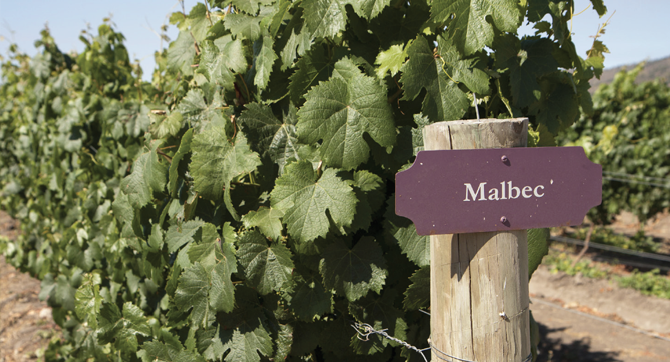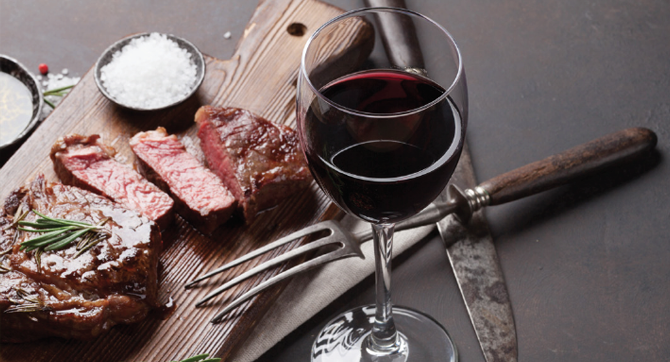Getting to Know Malbec
Referred to as “the working man’s Merlot,” Malbec is a wine with a more rustic full-bodied appeal that people prefer for its value and good straightforward taste.
Malbec was made popular by “regular people” in search of a wine with a nice price point that was easy-drinking with or without food. Malbec has simple flavors and notes of spice and smoke. It’s a wine that everyone can enjoy and afford. It is a thick-skinned grape that is a natural cross between two esoteric varieties that are from the French regions of Languedoc-Roussilon and Sud-Quest.
Once referred to as “the black wine of Cahors” in France, Malbec is one of the five Bordeaux varieties that include Cabernet Sauvignon, Merlot, Cabernet Franc and Petit Verdot. Primarily used as a blending grape in Bordeaux blends, it never surfaced as a top French wine due to the grape’s poor resistance to French weather and pests and found it’s main home in Mendoza, Argentina where it was planted by order of the mayor in 1868 by a French botanist.
Though presently very popular in Argentina, Malbec also makes its home as a top-rate California varietal. Prior to Prohibition in the United States, Malbec was a significant varietal in California and was used mainly for bulk wine production. After Prohibition, and much later in the mid-1990s, the grape gained more popularity as a component of the American “Meritage” Bordeaux-style blends. Though there are many producers that make single varietal Malbec wines, the grape is still mostly used for blending.
In California, the American Viticultural Areas (AVA) with the most plantings of Malbec include Sonoma Valley, Napa Valley Alexander Valley and the Central Coast. These regions have pockets of hot climates with high elevations where the Malbec grape flourishes the best. Other regions in California with some planting of Malbec include Lodi, El Dorado and Fair Play in the Sierra Foothills, many areas in the Central Coast and Yorkville Highlands in Mendocino to name a few.
The best Malbecs have a lifted acidity and smooth tannins and yet, some Malbec can be a bit rough around the edges with it’s added spice and smokey notes which makes it a different wine from it’s elegant and polished Bordeaux brother, Merlot. That being said, Malbec takes a strong position as an excellent wine choice that complements many occasions and food pairings.

get the dirt
Understanding terroir and its influences
Although Malbec’s origins are in France, it gained popularity in Argentina because it was much easier to grow there. The cool climates of the Loire and Bordeaux were not suited to the variety. Unfortunately, Malbec is quite susceptible to disease and is sensitive to viticultural conditions like frost, mildew and rot. When managed, the grape can produce healthy yields with good flavor profiles.
The grape flourishes in a hot climate where there are high-altitude and mountainous regions like those found in Mendoza, Argentina and many places throughout California Wine Country.
Malbec is a thin-skinned grape and likes more sun and heat than either Cabernet Sauvignon or Merlot to mature properly. High elevation areas with wide diurnal temperature shifts, that is long hot days and cool crisp nights, gives the grape good structure with more acidity. Malbec ripens mid-season and can offer a lovely deep color to a wine with enough tannin and a plum-like flavor.
Malbec can grow in many kinds of soils but seems to favor limestone-based soils like those found in its homeland of Cahors where the growing conditions seem to produce the most dark and tannic manifestation of the grape. In fact, Malbec grown in the different regions of France, Argentina and California each offer slightly different profiles with distinct flavor and compositional differences for the grape. In other words, where Malbec is grown has an influence on the style of Malbec that is produced.

swirl, sniff, sip, savor
How to identify wine in the glass
The grape typically produces wine of excellent color and concentration with juicy berry and black fruit flavors coupled with medium acid and moderate tannins. Malbec offers a smoky finish and a great alternative to higher priced Cabernet Sauvignon.
French Malbec is more leathery with flavors of tart currant, black plum and a bit more savory bitterness. Malbec from France may also have more acidity and softer notes of black pepper and spice. On the contrary, classic Argentinan Malbec wines, as well as Malbec from California, offer fruit flavors of blackberry, plum and black cherry. The more subtle flavors of milk chocolate, violet flowers, leather and cocoa are often present. A sweet tobacco finish will depend on the amount of oak aging. Typically Malbec is aged in oak anywhere from six months to a year.
The distinguishing quality of Malbec that sets it apart from all other wines is its color. Malbec has a purple color with a magenta-tinged rim. It’s the tell-tale sign that the wine is Malbec. Because of this inky violet color it is often blended with Merlot and Cabernet Sauvignon to create the a lovely Claret.
what’s in a glass?
The perfect glass to enjoy the nose and taste of Malbec is a glass with a wide bowl and a sort of narrow rim. When the wine is directed to the center of the tongue, it allows specific flavors to pop on the taste buds in the mouth. The narrow rim of the glass also helps to place the wine in the mouth to better perceive the sweet and smooth tannins and create a more silky texture to the wine.

how to pair like a pro
Malbec is a big, bold red wine that tips toward the higher end of the scale for alcohol, acidity and tannin content which makes it a very food-friendly pairing partner. The flavor elements of black cherry and blackberry fruits along with fig-like chocolate and a unique smoke, pepper and tobacco spice allows for this varietal wine to pair well with gamey dishes like roasted and stewed beef, braised lamb, mushrooms, herbs and sausage.
The classic pairing in Argentina is Malbec and steak. Malbec holds up well with meats and a recurring theme for pairing Malbec and food absolutely includes meat, as well as spice. For example, an herbed roasted beef tenderloin with black pepper and marjoram spice is a happy marriage of protein, fat and tannin with a strong round and full finish. The fruitiness in Malbec also complements more earthy meat cuts such as buffalo burgers and venison.
Malbec is a particularly nice wine to pair with spicy ethnic cuisines and spice-laden sauces. Some tasty examples include the sweet and tangy combination of a South Carolina barbecued pork or a cumin, paprika and chili pepper paste based beef stew or Thai barbecue chicken skewers. Malbec’s acidity offers enough juice to cut the fat of big meats and put a spotlight on the flavors of the spice without overpowering the dish.
For vegetable lovers, Malbec also has a place. The umami characteristics noted in the wine will favor medleys of mushrooms like porcini and portobello and sweet herbs like oregano, basil and thyme. Another favorable pairing of Malbec is with mint! Malbec is also one of the few big red wines that can pair well with pungent cheeses like blue cheese and gorgonzola. It will also go well with Monterey Jack, provolone and Swiss cheese. Since Malbec has a shorter finish than most bold red wines, cheeses that do not have a long finish will go well with it. For the vegetarian foodie in your life, Malbec is a nice option for cashew creams and cashew-based cheeses and, as mentioned, anything with herb-driven flavors.


